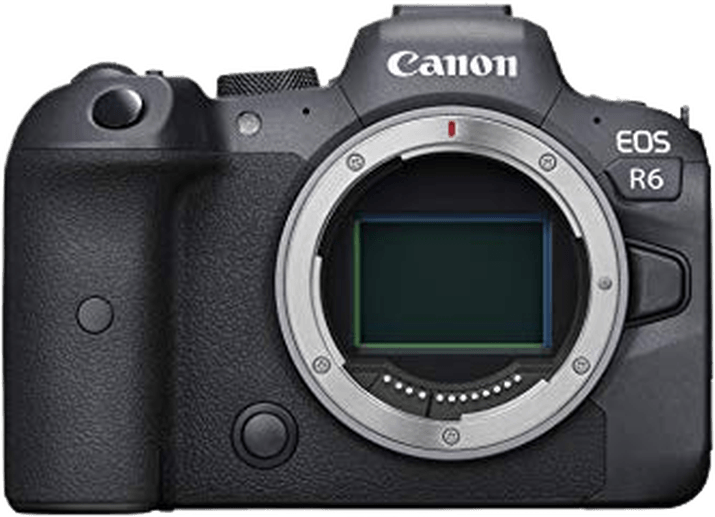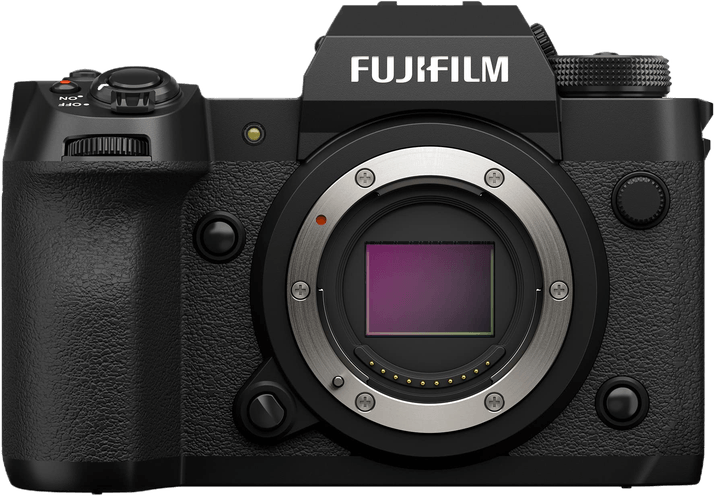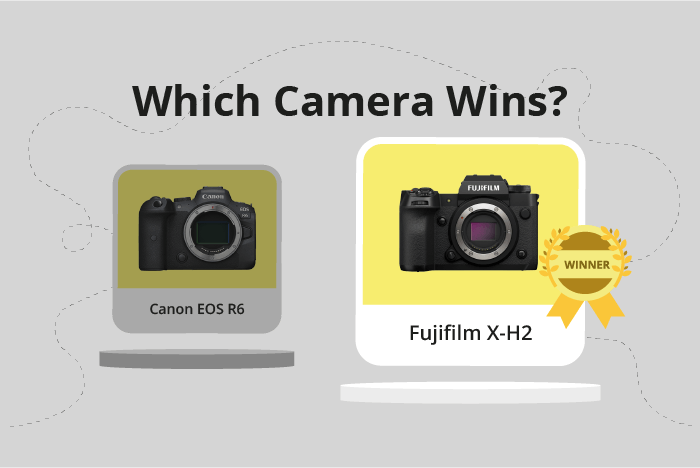Canon EOS R6 vs Fujifilm X-H2 Comparison
Canon EOS R6

Fujifilm X-H2

The Fujifilm X-H2 takes the lead with a score of 82/100, while the Canon EOS R6 trails closely behind at 80/100. Both cameras are mirrorless and share similar dimensions, with the X-H2 being slightly lighter at 660g compared to the R6’s 680g. The X-H2 also boasts a more recent release year (2022) and a lower launch price of $1999, as opposed to the R6’s 2020 release and $2499 price tag.
The Canon EOS R6, though slightly heavier, has a marginally larger body, potentially providing a better grip and feel for some users. However, the Fujifilm X-H2’s lighter weight and lower price make it an appealing choice for budget-conscious photographers seeking the latest technology.
Taking into account their scores, dimensions, weight, release years, and prices, the Fujifilm X-H2 emerges as the better option, offering a more recent release and a lower price without sacrificing performance. The Canon EOS R6, on the other hand, still delivers solid performance, but may be more suitable for those who prioritize a slightly larger body.
Canon EOS R6 vs Fujifilm X-H2 Overview and Optics
The Fujifilm X-H2 emerges as the winner in the optics comparison with a score of 81/100, while the Canon EOS R6 scores 79/100. Both cameras share similarities in their optics, such as having a CMOS sensor, image stabilization, and using their respective brand’s lens mount (Canon RF for the EOS R6 and Fujifilm X for the X-H2). Additionally, both cameras feature high-speed processors (Digic X for the EOS R6 and X-Processor 5 for the X-H2).
The Fujifilm X-H2 outperforms the Canon EOS R6 in terms of megapixels, offering a 40-megapixel sensor compared to the 20.1 megapixels of the EOS R6. This difference allows the X-H2 to capture more detail and produce higher resolution images. However, the EOS R6 has a faster shooting speed of 20 frames per second, compared to the X-H2’s 15 frames per second. This advantage allows the EOS R6 to capture fast-moving subjects more effectively.
Despite its higher score, the Fujifilm X-H2 has an APS-C sensor, while the Canon EOS R6 features a full-frame sensor. The larger sensor size of the EOS R6 provides better low-light performance and a shallower depth of field. Furthermore, the EOS R6 has a DXOMARK sensor score of 90, which is a reputable metric of sensor quality; unfortunately, DXOMARK does not score Fujifilm cameras.
Taking these points into consideration, the Fujifilm X-H2 is the better choice for photographers who prioritize higher resolution images, while the Canon EOS R6 is more suitable for those who need a faster shooting speed and better low-light performance. Ultimately, both cameras have their strengths and weaknesses, and the choice between them depends on individual preferences and requirements.
Canon EOS R6 vs Fujifilm X-H2 Video Performance
The Fujifilm X-H2 outshines the Canon EOS R6 in video capabilities. Both cameras share key video specifications, such as 3840 x 2160 max video dimensions and built-in time-lapse functionality, making them suitable for capturing dynamic scenes over time.
The X-H2’s higher score is due to its superior max video frame rate and 8K resolution, double that of the R^’s. This significant difference allowsthe Fujifilm model to capture smoother, more detailed footage, particularly in fast-moving situations or when creating slow-motion effects. However, the Canon EOS R6 still provides solid performance for most peoples video needs.
Canon EOS R6 vs Fujifilm X-H2 Features and Benefits
The Canon EOS R6 and Fujifilm X-H2 cameras share an equal feature score of 85/100. Both cameras possess several common specifications, contributing to their identical scores. These shared attributes include a 3-inch screen size, a screen resolution of 1,620,000 dots, touchscreen capabilities, flip screens, and no GPS. Additionally, both cameras have WIFI and Bluetooth connectivity.
The Canon EOS R6 excels in certain aspects compared to the Fujifilm X-H2. However, since both cameras have the same score, these differences are not significant enough to declare the Canon EOS R6 a clear winner. Instead, it is important to consider the specific needs and preferences of the user when determining which camera is best suited for their requirements.
Similarly, the Fujifilm X-H2 may outperform the Canon EOS R6 in some areas, but the equal scores suggest that these differences are not substantial. It is crucial for potential buyers to examine their individual needs and preferences to determine if the Fujifilm X-H2 is the better choice for them.
Ultimately, both the Canon EOS R6 and Fujifilm X-H2 are excellent cameras with a wide range of features. Their equal scores indicate that they are both high-quality options for photographers and videographers. Potential buyers should consider their specific needs, preferences, and intended use to make an informed decision about which camera will best meet their requirements.
Canon EOS R6 vs Fujifilm X-H2 Storage and Battery
The Fujifilm X-H2 wins the storage and battery comparison with a score of 79/100, while the Canon EOS R6 receives a score of 68/100. Both cameras have two memory card slots and offer USB charging. They also accept UHS-II compatible memory cards, with the X-H2 supporting CFexpress Type B and SD cards, and the R6 using SD/SDHC/SDXC cards.
The X-H2 outperforms the R6 in battery life, providing 680 shots per charge compared to the R6’s 360 shots. This longer battery life makes the Fujifilm X-H2 more suitable for extended shooting sessions. The R6, however, does not have any distinct advantages in storage and battery over the X-H2.
Considering these factors, the Fujifilm X-H2 proves to be the better choice for photographers who prioritize longer battery life and versatile storage options. Meanwhile, the Canon EOS R6 may still be a viable option for users who place a greater emphasis on other features and specifications.
Canon EOS R6 vs Fujifilm X-H2 – Our Verdict
Are you still undecided about which camera is right for you? Have a look at these popular comparisons that feature the Canon EOS R6 or the Fujifilm X-H2:

